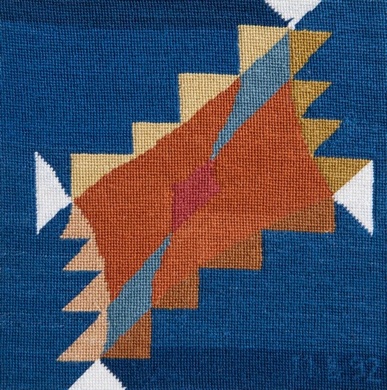never done
december 6, 2013 - january 30, 2014
never done
december 6, 2013 - january 30, 2014
Chandra Cerrito Contemporary


carol bernard
marlene bloomberg
andrea brewster
curated by
renny pritikin


Marlene Bloomberg
Tipsy, 1992
needlepoint
18 x 18 inches
Never Done, is a three-person exhibition curated by Renny Pritikin. The work of thinking about women’s work is never done. Contemporary artists not only push the limits of what visual art can be, but some also look back to forms and materials learned from their mothers and grandmothers to manifest that research. This exhibition includes three women from three generations whose experiences result in work that extends their formal and informal training in startling directions.
Carol Bernard, who was born in the 1920s, lived most of her life in Los Angeles, where she taught art in public schools. As a young girl on her own in depression-era Chicago, she had managed to survive and even put herself through college, majoring in art and education. Retired with her husband to Davis, outside of Sacramento, she took up painting and drawing with a rare discipline; the opposite of a Sunday painter, she works day and night, most days. Her pen and ink works on paper are all-over jangly lines that merge abstraction with suggestions of landscape and figuration. They’re dense, as in the most tangled work of such contemporaries as the illustrator Al Hirschfeld or the white-on-black scribbled lines of Cy Twombly from the early 70s. Like his, her lines are records of her mind’s wanderings that emerge through movement of her arm.
Marlene Bloomberg, who, sadly, passed away in 2013 during the planning of this exhibition, was born in Paris just before World War II. She was trained in the family business—making kepi, the distinctive flat-topped police hats—so that sewing and related skills were second nature to her. Like Bernard, she found herself living in Davis, in her case after marrying an American she met at the Sorbonne. She dedicated herself to needlepoint work, leaving approximately one hundred works in her estate. She took great pride in inventing original designs, neither strictly figurative nor landscape, and often verging on the abstract. At their most resolved, they are contemporary miniatures full of mysterious personal iconography rendered with consummate skill.
Andrea Brewster is in her forties and works in a form passed down from her mother and grandmother: tatting. She is trained as an artist and showed handwriting- based, extremely small and obsessive drawings extensively before starting a family. Since then her work has been seen privately and she has switched to making tatting, felt and crochet-based things. These forms reflect not only gender traditions but class ones as well, as lace was always an upper class indulgence, while the other forms were invented in the early 19th century, more readily available to middle class and working class women. Brewster makes gem-like small objects that shimmer with fragility, that sit in the hand like baby birds, vulnerable, almost too exquisite to exist in this world.
- Renny Pritikin, curator
About the Curator: Renny Pritikin was co-director of New Langton Arts, chief curator at Yerba Buena Center for the Arts and director of the Nelson Gallery at UC Davis. He gave a lecture series in Japanese museums in 1995, in New Zealand museums in 2003, the latter as a Fulbright Fellow, and was the curator for the United States exhibition at the Cuenca, Ecuador Biennal in 2004. He has been a senior adjunct professor in the curatorial practices graduate program at the California College of the Arts in San Francisco since its inception in 2003. He has been a frequent contributor to Art Practical, where he guest edited the initial issue on its new website this past September.

